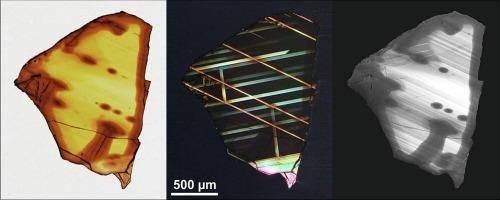Baddeleyite containing ordered srilankite (ZrTi2O6) from Eppawala, Sri Lanka
IF 2.5
2区 地球科学
Q2 GEOCHEMISTRY & GEOPHYSICS
引用次数: 0
Abstract
Megacrysts of baddeleyite have been found in a (latest Neoproterozoic) carbonatite near Eppawala, Sri Lanka. The material was characterised using a combination of structural, chemical and spectroscopic analysis techniques, revealing notable internal heterogeneity. The baddeleyite contains variable, significant volume fractions affected by secondary alteration. Further detailed studies will be needed before the material can be considered as potential primary reference material in U-Pb and other isotope-analytical studies. Most remarkable, however, is the occurrence of lamellae of ordered ZrTi2O6 (orthorhombic space group Pbcn with a = 14.198 ± 0.002 Å, b = 5.326 ± 0.001 Å, c = 5.002 ± 0.001 Å). Single-crystal X-ray diffraction and Raman microspectroscopy results, including a calculated spectrum, are presented for the newly recognised ordered form of ZrTi2O6. In this phase, Zr is eight- and Ti is six-coordinated. It seems to be a hitherto unknown polymorph: So far, only disordered ZrTi2O6 with both Zr and Ti in octahedral sites was known to occur in nature. Revisiting known srilankite samples appears worthwhile.

含有序斯里兰卡钛(ZrTi2O6)的白晶石,产自斯里兰卡埃帕瓦拉
在斯里兰卡埃帕瓦拉(Eppawala)附近的一处(最新的新元古代)碳酸岩中发现了坏辉石巨晶。该材料使用结构,化学和光谱分析技术的组合进行了表征,揭示了显着的内部异质性。坏榴辉岩含有可变的、显著的体积分数,受次生蚀变的影响。在将该材料视为U-Pb和其他同位素分析研究的潜在主要参考材料之前,还需要进行进一步的详细研究。然而,最值得注意的是有序ZrTi2O6(正交空间群Pbcn, a = 14.198±0.002 Å, b = 5.326±0.001 Å, c = 5.002±0.001 Å)片层的出现。给出了新发现的有序态ZrTi2O6的单晶x射线衍射和拉曼微光谱结果,包括计算谱。在这个阶段,Zr是八配位的,Ti是六配位的。这似乎是一种迄今为止未知的多晶型:到目前为止,只知道在自然界中存在Zr和Ti同时位于八面体位点的无序ZrTi2O6。重新考察已知的斯里兰卡风筝样本似乎是值得的。
本文章由计算机程序翻译,如有差异,请以英文原文为准。
求助全文
约1分钟内获得全文
求助全文
来源期刊

Lithos
地学-地球化学与地球物理
CiteScore
6.80
自引率
11.40%
发文量
286
审稿时长
3.5 months
期刊介绍:
Lithos publishes original research papers on the petrology, geochemistry and petrogenesis of igneous and metamorphic rocks. Papers on mineralogy/mineral physics related to petrology and petrogenetic problems are also welcomed.
 求助内容:
求助内容: 应助结果提醒方式:
应助结果提醒方式:


